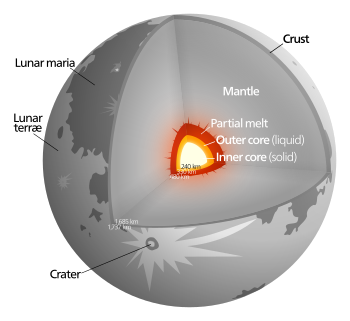Our moon is the satellite of our Earth. Our Moon is the brightest and largest object in the night sky. The Moon was named as the "Moon" because there wasn't any other moon discovered, that time. In 1610, Galileo Galilei discovered four moons or Galilean moons orbiting Jupiter. In Latin, our Moon was called Luna, which is our Moon-related: lunar.
Size and Distance
The size and distance of our Moon, with a radius of, 1,737.5 kilometres. Our Moon is less than a third of Earth. Did you know that the moon is far away than most people think, the moon is an average 384,400 km away from Earth. That means that there would be 30 Earth-sized planets between the Earth and the moon. If the Earth was a size of a nickel than the moon would be the size of a coffee bean. The moon is getting about 2.54 centimetres away from Earth every year.How did the moon form?
The theory of the moon being formed is when a Mars-sized body crashed into Earth about 4.5 billion years ago.The moon's core is smaller than other inner planets. The hard, iron-rich inner core is 240 km in radius.
Structure
 The surrounded liquid iron shell, 90 km thick. A partly molten layer with a thickness of 150 km, surrounds the iron core. The mantle expands from the top of the partly molten layer to the bottom of the moon's crust. It is more likely made of minerals like, olivine and pyroxene, which are made up of magnesium, iron, silicon with oxygen atoms.
The surrounded liquid iron shell, 90 km thick. A partly molten layer with a thickness of 150 km, surrounds the iron core. The mantle expands from the top of the partly molten layer to the bottom of the moon's crust. It is more likely made of minerals like, olivine and pyroxene, which are made up of magnesium, iron, silicon with oxygen atoms.Atmosphere
The moon's atmosphere is very thin and weak, called an exosphere. The atmosphere doesn't provide any protection from the sun's radiation or the impacts of meteoroids.
Missions
 |
| Left: Neil Armstrong Center: Michael Collins Right: Buzz Aldrin Credits: wikipedia.com |
 |
| Luna 1 spacecraft Credits: wikipedia.com |
The first seven missions were unsuccessful, there were four Pioneer spacecrafts, that had failed. But Luna 1, was the first moon flyby.
Luna 1 launched on January 2, 1959. The next Luna spacecraft, Luna 2 was fully successful. Luna 2 was the first spacecraft to impact the moon's surface. On September 14, 1959, Luna 2 reached to the moon by crashing the moon. Luna 3, had a flyby, it was successful, Luna 3 took the first pictures of the lunar farside. Most of the Luna spacecrafts had succeeded, but some had been unsuccessful. Luna 9 was the first lunar soft landing and the first picture from the lunar surface.
Surveyor 1 was the first U.S. moon landing and first U.S. photo from the lunar surface.
Apollo 8 was successful and was the first humans to orbit the moon. Apollo 11 was a famous knowing spacecraft because Neil Armstrong, Michael Collins and Buzz Aldrin were the first humans to land on the moon. Neil Armstrong and Buzz Aldrin were the only two to step on the moon.
Luna 1 launched on January 2, 1959. The next Luna spacecraft, Luna 2 was fully successful. Luna 2 was the first spacecraft to impact the moon's surface. On September 14, 1959, Luna 2 reached to the moon by crashing the moon. Luna 3, had a flyby, it was successful, Luna 3 took the first pictures of the lunar farside. Most of the Luna spacecrafts had succeeded, but some had been unsuccessful. Luna 9 was the first lunar soft landing and the first picture from the lunar surface.
Surveyor 1 was the first U.S. moon landing and first U.S. photo from the lunar surface.
Apollo 8 was successful and was the first humans to orbit the moon. Apollo 11 was a famous knowing spacecraft because Neil Armstrong, Michael Collins and Buzz Aldrin were the first humans to land on the moon. Neil Armstrong and Buzz Aldrin were the only two to step on the moon.
What I've learnt?
- In Latin, the moon means lunar.
- Our moon is less than a third of our Earth.
- 30 Earth-sized planets could fit between the Earth and the moon.
- The moon is getting 2.54 centimetres away from Earth every year.
- Our moon formed 4.5 billion years ago.
- In our Moon, there are elements like olivine, pyroxene, magnesium, iron, silicon, and oxygen atoms.
- The atmosphere is very thin and weak, that is called an exosphere.
- The first seven moon missions had failed. Luna 1 was the first layby spacecraft to reach the moon. Luna 2 had reached the moon's surface.

